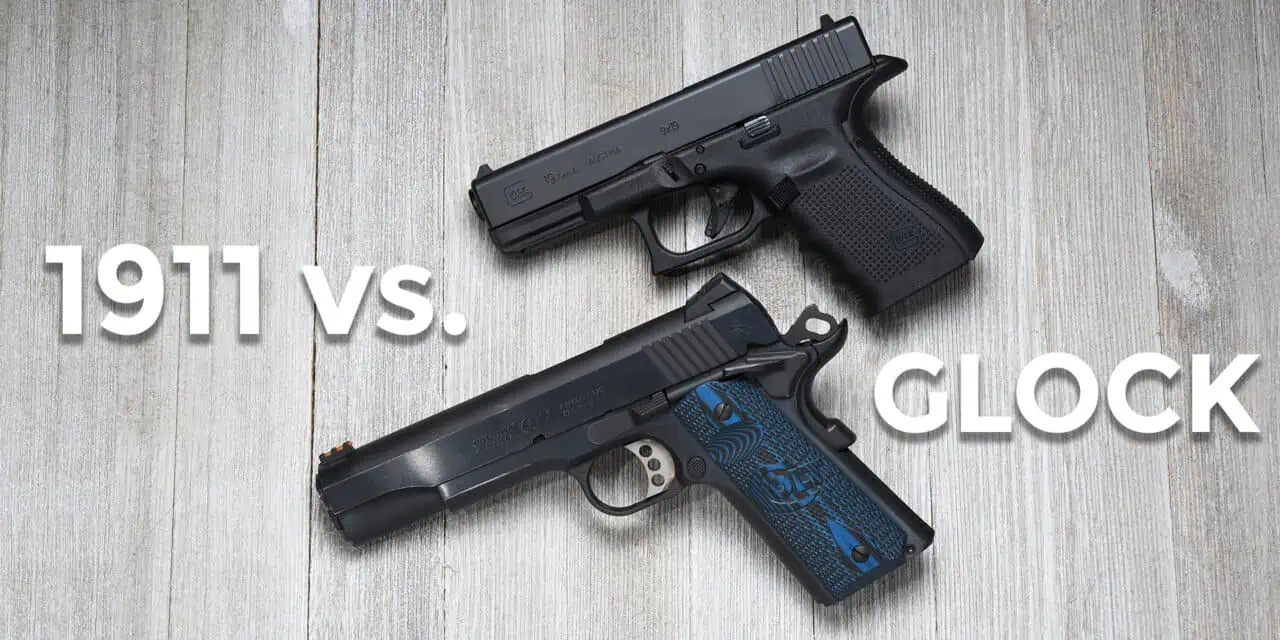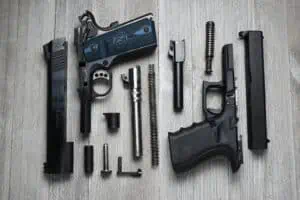Showdown: 1911 vs Glock
Coke vs Pepsi. Ford vs. Chevy. The Beatles vs. The Stones. Gordie Howe vs. Wayne Gretzky. Okay, that last one might be limited to just the hockey fans out there, but you get the idea. There are classic rivalries in every field of human endeavor, and it’s true of pistols as well, and 1911 vs Glock is probably the biggest one of all. Let’s take a look at both those guns, and compare their weaknesses and their strengths.
Oh, and by the way, Gordie Howe. Definitely Gordie Howe. I digress.
First off, let me say I have no preference one way or another between these two pistols. My pistol of choice, all things considered, is the classic CZ75 in 9mm. Like the 1911, it is an all-metal, hammer-fired gun. The CZ75 is also a higher-capacity 9mm like the original Glock model, the Glock 17. I’m not saying my love of the CZ makes me completely neutral, but at least you know my biases right up front. Let’s begin with taking a look at how 1911-style pistols came about, as well as the history of Glock products.
History of the 1911
The iconic 1911 pistol was designed by John Moses Browning around the turn of the last century. The U.S. Army was unsatisfied with the performance of its current service pistol, a .38 revolver, and they were looking for a replacement with a little more punch. Proposals for a new pistol came in from a variety of manufacturers, including DWM, who created both the Luger pistol and 9mm Luger ammo. Browning’s design, produced by Colt, was chosen as the winner, partially because it was more reliable than the other pistols it faced.
Over the years, the 1911 design has evolved to increase its performance and adapt it to different roles. The size of the pistol shrank to make it more easy to carry. The components of the gun changed, with alloy and eventually polymer frames being introduced to reduce the weight of the gun. The 1911 has been produced in many different calibers, from .22LR all the way up to .50GI. The original seven-round capacity of the magazine has been expanded to eight, and even more rounds are available with extended magazines.
The 1911 has been a staple of American gun culture for over a century now, and has proven itself in the battlefield and in a variety of different shooting sports. However, it is a gun that was created when manpower was cheap and machines were expensive. The reliability of the 1911 depends, in a large part, on how well the magazine feeds rounds into the gun. Finding magazines which worked well with a 1911 was a bit of a hit or miss proposition until improved designs were rolled out by Bill Wilson and Chip McCormack, but the hit on the 1911’s reputation for reliability continues to this day.
History of Glock
Just like the 1911, the design of the Glock pistol sprang from a military competition. The Austrian military was still using WWII era service pistols, and so in 1980, they created a competition to find a replacement. The winner of this competition was a small company founded by Gaston Glock, which did not have a history of making firearms up until that point. What Glock did, however, was assemble a team of firearms experts and military personnel to dream up what they would want in a pistol which met the requirements of the Austrian military, and thus, the Glock 17 was born.
The Glock 17 didn’t break any new ground with regards to technology. It is a striker-fired gun, which has been around since the early 1900’s. The frame is made from polymer, which was first rolled out in the early 70’s with the Heckler & Koch VP70. Higher-capacity double-stack magazines had been in use since the introduction of the Browning Hi-Power in the mid-1930’s, and a built-in trigger safety as a hallmark of the Iver Johnson “Safety” line of revolvers, first introduced in the 1890’s.
What was groundbreaking, however, was putting all of those technologies together in one pistol. The Glock 17 was a revolutionary design which, like the 1911 before it, changed and adapted to serve different functions. Glock pistols are available in calibers ranging from .22LR to 10mm Auto, and in sizes from small, lightweight pocket guns to extended-length boomers perfectly suited to handgun hunting. Unlike pistols which use the 1911 design, which has been copied by dozens, if not hundreds of manufacturers, Glock pistols have been made exclusively by Glock since their introduction.
Common Roots
Both pistols share a common origin in military trials and now serve different purposes than their original designs. However, there are many differences between a 1911 vs Glock. Glocks are striker-fired, 1911s are single action, hammer-fired guns. Glocks make extensive use of polymers, while almost all 1911s are made from metal. A 1911 style pistol has a grip safety on the back of the pistol and a frame-mounted safety. A Glock has a safety inside the trigger as well as two other safeties inside the action.
To test the functional differences between these two guns, we’ll shoot each gun from a rest at a target that’s 15 yards away. We’ll also record the velocity of each round using a Pro Chrony chronograph positioned 15 yards away from the muzzle. We will test the reliability of each gun using our standard 300 round reliability test, shooting both FMJ and JHP rounds. Finally, we will compare the firepower of each pistol. We will calculate this by multiplying the muzzle energy of the rounds we tested by the capacity of each gun. This will give us an idea of how much damage each gun is potentially able to do to a target. We will also test the trigger pull weight between each gun.
Putting Icons To The Test
The guns we’ll be using are both iconic examples of a 1911 and a Glock. The 1911 is a full sized Colt Competition chambered in .45 ACP. It is a Series 70 style gun, which means it has the classic 1911 trigger, with a short amount of travel and nice, crisp break. The metal frame and large size of this gun give it a hefty unloaded weight of 36 ounces
The Glock we’ll be testing is also an iconic gun, the Glock 19. The 19 is slightly smaller than Glock’s full-sized service gun, the Glock 17. However, the 19 is one of America’s most-popular firearms and a common choice for concealed carry. The smaller size of the Glock 19 Gen 5 we’re using and the use of lightweight polymers in the frame mean that it tips the scales at just over 21 ounces.
Accuracy
We shot the same type of ammo in each to test their accuracy. The rounds we tested were as follows
Fiocchi 115 grain 9mm FMJ
Average Velocity: 1110 fps
Average Group Size: 2.38 inches
Fiocchi 230 grain .45 ACP FMJ
Average Velocity: 866 fps
Average Group Size: 2.36 inches
Federal 147 grain 9mm HST JHP
Average Velocity: 995 fps
Average Group Size: 2.69 inches
Federal 230 grain .45 ACP HST JHP
Average Velocity: 863 fps
Average Group Size: 2.43 inches
Blazer 115 grain 9mm FMJ
Average Velocity: 1113 fps
Average Group Size: 2.27 inches
Blazer 230 grain .45 ACP FMJ
Average Velocity: 789 fps
Average Group Size: 2.5 inches
When it comes to accuracy, the Glock 19 and the Colt 1911 delivered very similar results. Keep in mind both of our pistols are completely stock. The sights, trigger and barrel they have are what came from the factory. Improving these parts will doubtlessly improve the accuracy of both these guns.
Reliability
We shot 300 rounds through each of our test guns. Neither gun had any issues with our test ammo. Glocks have a reputation for being ferociously reliable, and this Glock 19 lived up to that reputation.
The Browning design for the 1911 won the design competition based in part on its reliability, but in recent years, there have been questions about the 1911’s ability to shoot without issues. The fact is, though, that with 1911s, just as with other guns, the more you pay for the gun, the more care is put into making the gun perform at the highest levels.
Firepower
The Colt Competition 1911 holds 8+1 rounds of .45 ACP, and the Glock 19 holds 15+1 of 9mm in a standard capacity magazine. If we use the muzzle velocities of both the 9mm HST and the .45 HST from our test to calculate the muzzle energy of each gun, and then multiply that by the capacity of each gun, we can arrive at a number which gives us any idea of how much potential damage each gun is capable of inflicting on a target.
Colt 1911
Muzzle Energy, Federal 230gr HST: 380.37 ft/lbs
Firepower Rating: 3423
Glock 19
Muzzle Energy, Federal 115gr HST: 322.98 ft/lbs
Firepower Rating: 5168
.45ACP is a big round which travels relatively slow compared to 9mm. Much has been written about the vaunted “stopping power” of the .45. The fact is, however, advancements in bullet design and testing have closed the gap between the performance gap between how .45 ACP performs when it impacts the target.
Conclusion
Given its lighter weight and the drastic difference in firepower with a 1911 vs a Glock, the clear choice for a carry gun would be a Glock 19. However, that doesn’t mean that carrying a 1911 is a bad idea. Quite the contrary, in fact. To be honest, the only reason why I haven’t carried my 1911 on a regular basis is because it’s a 1911 that is specifically built for shooting matches, and not something I want to carry with me everyday.
Technology marches on. The 1911 represented the pinnacle of firearms technology in the early 1900’s, and it is still a very viable defensive pistol. But is it the most efficient defensive pistol out there today? No, not really. However, it can still do the job, and do it well.
Consider this analogy. Not too long ago, the 60’s era muscle car was considered to be the height of American automotive performance. Cars from the 1960’s were built by hand and had big V8 engines that required a tanker full of gasoline to get from Point A to Point B. Times have changed, though, and modern materials and manufacturing techniques are used to build high-performance cars. Because of this, the current interpretations of those classic cars turn in acceleration and handling numbers that were unheard of 50 years ago. Does that make a classic muscle car undesirable? No. What it does mean, though, is that the cars of today are some of the fastest, best-handling cars ever made, so if you’re looking to maximize your performance, look to choosing a modern pistol like a Glock or something similar over an older, yet still outstanding 1911 pattern pistol.







Why didn’t you do this comparison with a Glock 21? It would have made more sense.
I wanted to compare the iconic versions of each type of pistol. The Glock 19 is the Toyota Camry of Glocks, and for decades, “Colt” always came in front of “1911.”